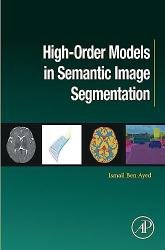 Название: High-Order Models in Semantic Image Segmentation
Название: High-Order Models in Semantic Image SegmentationАвтор: Ismail Ben Ayed
Издательство: Academic Press/Elsevier
Год: 2023
Страниц: 250
Язык: английский
Формат: epub (true)
Размер: 10.1 MB
High-Order Models in Semantic Image Segmentation reviews recent developments in optimization-based methods for image segmentation, presenting several geometric and mathematical models that underlie a broad class of recent segmentation techniques. Focusing on impactful algorithms in the Computer Vision community in the last 10 years, the book includes sections on graph-theoretic and continuous relaxation techniques, which can compute globally optimal solutions for many problems. The book provides a practical and accessible introduction to these state-of-the-art segmentation techniques that is ideal for academics, industry researchers, and graduate students in Computer Vision, Machine Learning and medical imaging.
In a breadth of applications, current supervised Deep Learning models are typically trained and evaluated on limited numbers of images and semantic classes. Therefore, despite their huge recent impact, they may have difficulty capturing the substantial variability encountered in real scenarios. Building manually labeled data covering the overwhelming amounts of real-world scenarios is infeasible because this would require unreasonably huge efforts by humans. In particular, this is the case when supervision requires scarce human-expert knowledge, as is the case in medical imaging, or when dealing with prohibitively time-consuming and dense-prediction tasks involving the manual labeling of millions of pixels per image, as in semantic segmentation.
Weakly-supervised learning methods, which use limited sets of annotated images and unlabeled data, are currently attracting wide research interest. Imposing priors on deep networks can mitigate the lack of annotations, leveraging unlabeled samples with prior knowledge. This chapter discusses how some of the pairwise or high-order regularizers discussed in the book could be very useful in weakly supervised segmentation. More specifically, we discuss several loss functions that impose regularization and edge alignment priors on the probability outputs of a deep network. Adding unsupervised loss terms, such as pairwise CRF regularization or high-order balanced graph clustering, can achieve performances close to full supervision, while using only fractions of the ground-truth labels. We discuss various optimization strategies for regularization losses in the context of deep-network segmentation. In particular, we discuss a general alternating direction method strategy for training neural networks that makes it possible to directly take advantage of powerful discrete graph-cut solvers for CRF losses, providing an effective optimization alternative to standard gradient descent.
Gives an intuitive and conceptual understanding of this mathematically involved subject by using a large number of graphical illustrations
Provides the right amount of knowledge to apply sophisticated techniques for a wide range of new applications
Contains numerous tables that compare different algorithms, facilitating the appropriate choice of algorithm for the intended application
Presents an array of practical applications in computer vision and medical imaging
Includes code for many of the algorithms that is available on the book’s companion website
Скачать High-Order Models in Semantic Image Segmentation